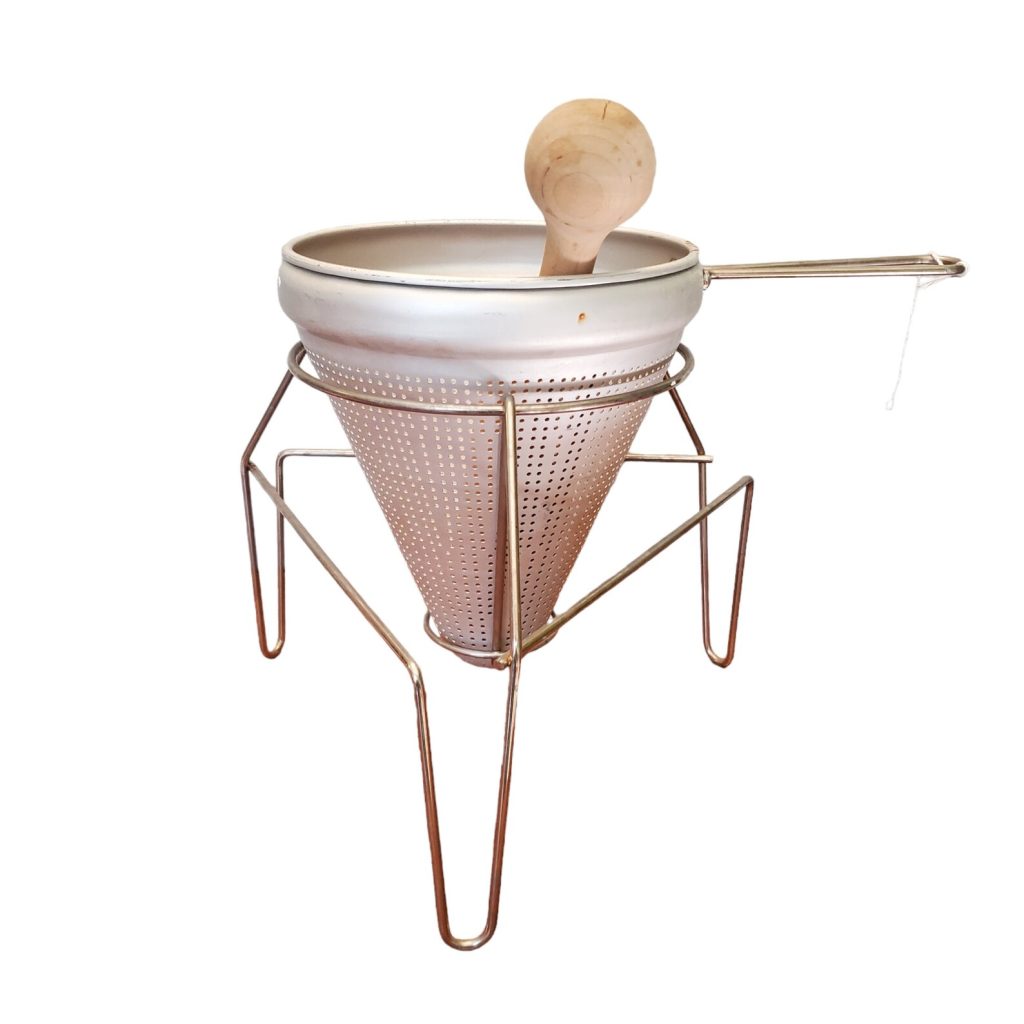If you walk into a home hardware store or scroll through an online shop, you might feel overwhelmed by seemingly endless types of kitchen tools. At this point, there seems to be a gadget for almost every kind of cooking-related activity. For example, you can buy your own corn-on-the-cob peeler, avocado corer and slicer, strawberry stem remover, egg cookers, and even a hot dog and bun toaster. But professional chefs don’t usually invest in single-purpose tools. They take up too much space without providing much utility in return. Minimalists and people with limited kitchen space may agree the more functions the better. Enter the cone strainer, also known as the chinois.
The Multi-Purpose Cone Strainer
Momofuku Nishi executive chef Nick Tamburo considers the colander not multi-functional enough, especially compared to a similar device. “I don’t think I’ve ever used one,” says Tamburo. “It doesn’t have that many practical applications. You can use a chinois for everything you would use a colander for, plus so much more. Its selling point is its versatility.” [1]
The chinois is a cone strainer made of fine aluminum mesh. It’s often accompanied by a stand and a pestle to push food items through the sieve. But it also has a wide brim to fit over a pot or sink. More importantly, they have seemingly endless uses beyond rinsing vegetables and draining noodles. “You can pass a pureed soup or sauce through it to get a very fine texture, strain your own homemade nut milks, sift flour and other dry ingredients for baking, or make a very smooth ice cream base,” Tamburo says.

Read: 9 Things We Used To Do in The Kitchen That Just Don’t Happen Anymore
Other uses can include straining stocks, soups, purees, homemade jams, custards, gravies, mashed potatoes, or any food that needs a smooth consistency. A wooden pestle or spatula can help press the food through the cone strainer to achieve the desired texture. You could even use the chinois to dust food with icing sugar or cocoa.
“I don’t know why home cooks don’t use them more often,” Tamburo says. “They’re dishwasher-safe, easy to store on hooks, and last forever.” He recommends an 8- to 10-inch size, paired with a 2-ounce ladle or a silicone spatula to help push liquids through. “Colanders just aren’t very multipurpose. Why get one when you could have something that does so much more?”
The chinois is very similar to the China cap, named after the traditional conical hats. China caps also have a distinct cone shape, but instead of fine mesh, they are solid metal with larger holes. Their functions are similar since you use a pestle to roll against the sides of the cap to work soft foods and liquid through it. You could also use a ladle instead of a pestle since it could press the food and scoop it up from the sides of the strainer. However, China caps produce a thicker and less smooth consistency than the chinois. So, think about what you would use these tools for to decide which type would be more helpful for you. [2]
Read: I’m Positive You Will Not Know What This Is. Go Ahead And Prove Me Wrong (If You Can)
How to use the chinois and/or the China cap
For stocks: Place the cone strainer over a large bowl. Then, slowly pour the stock into the cone. Most of the liquid will automatically go into the bowl, but don’t discard the remaining solids just yet. Use a pestle or a ladle to press against the food to release the juices and flavor. Next, let the stock cool and refrigerate for a couple of hours or until the fats solidify. Skim off the fat, and your stock is ready for use.
For soups and sauces: First, simmer vegetables, herbs, and spices in a broth or stock until the flavors release and the vegetables are soft. Puree the soup in a food processor or hand blender. But for a smoother texture, pour the soup through the cone strainer to remove leftover stems and seeds. Use a pestle to mash down the remaining pieces of vegetables and push them through the strainer.
For custards or curd: Silky and smooth textures are key for these kinds of dishes but they can easily contain lumps of eggs or starch. Simply pour the custard or curd into the cone strainer over a large bowl. Then, use the pestle to mash and press any pieces left behind.
More examples: Blanch vegetables by placing the greens into boiling water and quickly removing them using the cone strainer. You can similarly use this tool while frying foods to quickly remove onion rings, fritters, etc., from hot oil. And if you enjoy brewing, fill the cone with tea leaves and simmer it in a pot.
Keep Reading: Tiktoker Discovers New Way To Use A Strainer. What Do You Think?
Sources
- “Why You Should Skip a Colander and Buy a Chinois.” Eater. Jamie Feldmar. June 13, 2019
- “The Old-School, No-Electricity ‘Blender’.” Yahoo Life. Julia Bainbridge. August 18, 2015
- “Using a Chinois.” Williams Sonoma. Williams-Sonoma Kitchen.

